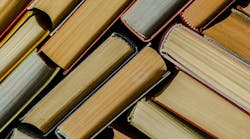You do still use books, don’t you? Even with the vast resources on the internet, most of us still go to books for in-depth material on subjects of interest. Or do you? I know I still do. As a writer, I am in constant need of background material, fundamentals, theory, explanations, and so on. Though I get a great deal from the internet, books are still useful. But there seems to be some books that I consult more often than others. Here’s a short list of the books I like, have learned from, and have found useful over the years.
My all-time favorite microwave books are the 28 volumes of the MIT Radiation Lab series. The Rad Lab existed in during World War II to develop microwaves and especially radar. These in-depth books are fantastic. I was lucky enough to work in a company early in my career that had a full set of these. I now have the entire series on a CD. Great references even today.
A more recent favorite is Planar Microwave Engineering by Thomas Lee of Stanford. This is a Cambridge University Press book. Very broad coverage on all microwave related topics. The writing style is such that it is easy to read for a technical book. A great engineering reference if you need a refresher or just an intro to a topic you never learned, this is a good source.
A go-to book of mine is Reference Data for Radio Engineers published by ITT. I don’t know where I got the book; it’s loaded with basic RF and microwave info. Math, tables, definitions, design formulas, etc. My raggedy copy has a copyright of 1949, but the content is still useful and valid. I bought it in a used book store and I doubt it is still being published.
Another good general RF book is The ARRL Handbook for Radio Communications. The American Radio Relay League is an organization for hams (licensed radio amateurs) that’s been around since 1914. It publishes QST magazine and many books. The Handbook, updated and published every year, covers radio and electronic theory and all aspects of communications. I have many copies including some collector copies from 1942 and 1953. Very practical and loaded with projects you can build. They also have a great antenna handbook.
Two books that I essentially learned RF and microwave from are oldies. Used book stores were the source. One of them you may have heard of if you’re old enough: Frederick Terman’s Electronic and Radio Engineering. My copy has a date of 1955 on it. Still a useful reference. Another oldie but goodie I learned from is Generation and Transmission of Microwave Energy, TM 11-673, Department of the Army, 1953. The Navy also had some good microwave and radar books.
If you want to finally understand transmission lines and SWR once and for all, get a copy of Reflections III by Maxwell. The CQ Communications book presents a real-world discussion of transmission lines, impedance matching, the Smith chart, SWR, and related topics. More than you ever wanted to know.
Speaking of the Smith chart, the book Electronic Applications of the Smith Chart by Phillip Smith is good one to learn from. Noble Publishing is the source, but may not still be around. You can’t not know the Smith chart and claim to be a microwave engineer.
Another favorite is RF Circuit Design, 2nd edition by Chris Bowick. Good coverage of filters, impedance matching, Smith chart and amplifiers. Still available from Newnes/Elsevier.
One book I go back to again and again is Volakis’ Antenna Engineering Handbook by McGraw-Hill. A real tome but a good reference. And if you want a good source of electronic warfare books, try Artech House. Big bucks, but I have most of them.
Finally, I always have copies of the latest Code of Federal Regulations (CFR) 47 Parts 0 through the End. Three volumes available from the Government Printing Office. I prefer the hard copies, but it’s all available on the FCC website. Practically all wireless engineering requires that you know these rules and regulations, so they’re not only useful, but necessary as well.
Books got expensive over the years. Prices are high to justify publishing low-volume books. Luckily you can almost always find used copies at significantly lower prices. And it used to be that book content lagged the technology. Today, most publishers anticipate the technology and find ways to get books published faster. The lag will always be there, much the time it takes to write a good book and get it published.
Next time you need a reference or knowledge source, do a book search. There are lots of books out there you’re probably not aware of. If the price is stifling you, buy used as I often do. And get on the publishers email list to get notices of new books in your field.
What are your favorite books? Old or new? What did you learn from and what do you use for reference today? We would love to hear.

